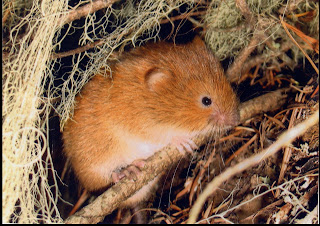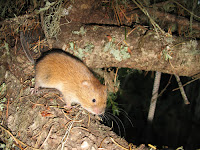

 |
| Photograph by Michael Nichols, National Geographic |
The Red tree Vole is a Rodent 6 to 8 inches in length that lives in the tops of old growth Douglas fir trees located in the western Cascades and coastal regions of Oregon. As the forests are decimated, for the growth of humans and their needs so is the habitat for these little critters. The spotted owl feeds on them which means as their numbers diminish so to will the owls. The entire eco system is threatened by man's unthinking and disrespectful ways. The Red tree vole feeds exclusively on Douglas Fir needles and gets it's water from the dew. I personally have never seen one, they live in the upper branches of the trees and when the young leave the nest the are likely to build their nest in the next branch. They will jump up to 100ft to the ground to escape a predator. These little guys are very mouse like with their tail being half of the body length. They are a specialized creature in their habits and an important part of the the eco system of the area. They go the spotted owl goes and on down the line.
Photos thanks to Google Search. For more info on Oregon wildlife:http://www.oregonwild.org/fish_wildlife/wildlife-pages/red-tree-vole
To participate read about and leave your link on the Mr.Linky on Rachel's Blog here; http://rhymemeasmile.blogspot.com/2011/09/smiley-sociology-study-8-rare-animals.html
and read all the other links as well....


Great post, Jan! I've never heard of the tree vole. That is definitely a rare animal worth including in the study. :)
ReplyDeleteHi Jan what a cute critter, such a shame it is endangered and also for the spotted owl. I love owls and I love your entry. Found it via Rachels Smiley Sociology Study. You can find mine about a busy platypus's life on Mr Linky under Morgaine620. Have a great day!
ReplyDeleteHi, while volunteering for NEST, I took all of the photos above except the National Geographic one. Could you credit Northwest Ecosystem Survey Team, and provide a link to our site:
ReplyDeletehttp://nestcascadia.wordpress.com/